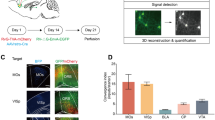Abstract
In recordings from anterior piriform cortex in awake behaving mice, we found that neuronal firing early in the olfactory pathway simultaneously conveyed fundamentally different information: odor value (is the odor rewarded?) and identity (what is the smell?). Thus, this sensory system performs early multiplexing of information reflecting stimulus-specific characteristics with that used for decision-making.



Similar content being viewed by others
References
Zhang, X. & Firestein, S. Results Probl. Cell Differ. 47, 25–36 (2009).
Kay, L.M. & Laurent, G. Nat. Neurosci. 2, 1003–1009 (1999).
Doucette, W. et al. Neuron 69, 1176–1187 (2011).
Roesch, M.R., Stalnaker, T.A. & Schoenbaum, G. Cereb. Cortex 17, 643–652 (2006).
Rennaker, R.L., Chen, C.F., Ruyle, A.M., Sloan, A.M. & Wilson, D.A. J. Neurosci. 27, 1534–1542 (2007).
Blumhagen, F. et al. Nature 479, 493–498 (2011).
Gottfried, J.A. Nat. Rev. Neurosci. 11, 628–641 (2010).
Smear, M., Shusterman, R., O'Connor, R., Bozza, T. & Rinberg, D. Nature 479, 397–400 (2011).
Gschwend, O., Beroud, J. & Carleton, A. PLoS ONE 7, e30155 (2012).
Miura, K., Mainen, Z.F. & Uchida, N. Neuron 74, 1087–1098 (2012).
Cury, K.M. & Uchida, N. Neuron 68, 570–585 (2010).
Shusterman, R., Smear, M.C., Koulakov, A.A. & Rinberg, D. Nat. Neurosci. 14, 1039–1044 (2011).
Chaput, M.A. Physiol. Behav. 36, 319–324 (1986).
Pager, J. Behav. Brain Res. 16, 81–94 (1985).
Piette, C.E., Baez-Santiago, M.A., Reid, E.E., Katz, D.B. & Moran, A. J. Neurosci. 32, 9981–9991 (2012).
Rennaker, R.L., Miller, J., Tang, H. & Wilson, D.A. J. Neural Eng. 4, L1–L5 (2007).
Doucette, W. & Restrepo, D. PLoS Biol. 6, e258 (2008).
Slotnick, B.M. & Restrepo, D. in Current Protocols in Neuroscience (eds. Crawley, J.N. et al.) 1–24 (John Wiley and Sons, New York, 2005).
Curran-Everett, D. Am. J. Physiol. Regul. Integr. Comp. Physiol. 279, R1–R8 (2000).
Benjamini, Y. & Yekutieli, D. Ann. Stat. 29, 1165–1188 (2001).
Benjamini, Y. & Yekutieli, D. Genetics 171, 783–790 (2005).
Wesson, D.W., Donahou, T.N., Johnson, M.O. & Wachowiak, M. Chem. Senses 33, 581–596 (2008).
Acknowledgements
We thank G. Felsen and N. Schoppa for discussions. This work was funded by grants from the US National Institutes of Health and the National Institute on Deafness and Other Communication Disorders (F32 DC011980 to D.H.G., F31 DC011202 to J.D.W., F30 DC008066 to W.D., R01 DC00566 to D.R. and P30 DC04657 to D.R.).
Author information
Authors and Affiliations
Contributions
J.D.W. and D.R. formulated the experimental paradigm and designed all the experiments. J.D.W. performed all the experiments and extracted single and multi-units from the raw data. D.H.G. and D.R. performed analysis of the data and generated all the figures. W.D. and D.R. set up the awake behaving recording system and D.R. wrote all programs necessary to run the experiments. W.D. trained J.D.W. on how to perform surgeries and run the experiments with awake behaving mice. All authors had the opportunity to discuss the results, participated in writing and made comments on the manuscript.
Corresponding author
Ethics declarations
Competing interests
The authors declare no competing financial interests.
Supplementary information
Supplementary Text and Figures
Supplementary Figures 1–8 (PDF 4200 kb)
Rights and permissions
About this article
Cite this article
Gire, D., Whitesell, J., Doucette, W. et al. Information for decision-making and stimulus identification is multiplexed in sensory cortex. Nat Neurosci 16, 991–993 (2013). https://doi.org/10.1038/nn.3432
Received:
Accepted:
Published:
Issue Date:
DOI: https://doi.org/10.1038/nn.3432
- Springer Nature America, Inc.
This article is cited by
-
Molecular layer interneurons in the cerebellum encode for valence in associative learning
Nature Communications (2020)
-
Detection of Activation Sequences in Spiking-Bursting Neurons by means of the Recognition of Intraburst Neural Signatures
Scientific Reports (2018)
-
Activity in the rat olfactory cortex is correlated with behavioral response to odor: a microPET study
Brain Structure and Function (2017)
-
Vagus Nerve Stimulation Alters Phase Synchrony of the Anterior Cingulate Cortex and Facilitates Decision Making in Rats
Scientific Reports (2016)





